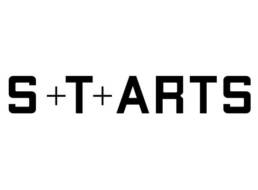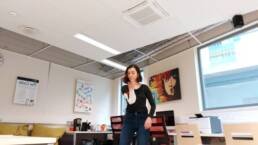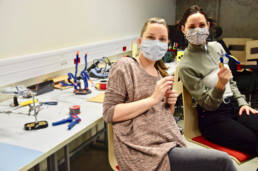STARTS.EE art+science residency
Call for Artist and for Creative Technologist
Topic: Wearable Vibro-Tactile Interfaces
About
STARTS.EE is an umbrella initiative promoting encounters between science, technology, and the arts, for the benefit of society. The goal of the initiative is to open up Tallinn University research and development activities to the outer world, strengthening its abilities and increasing societal and cultural impact.
Residencies, organised in collaboration with STARTS.EU and e⁻lektron, aim at kickstarting artistic and scientific or technological collaborations that lead to transdisciplinary novel ideas that enrich the existing practices of both domains.
A residency is a form of collaboration where an artist and a researcher or technologist can work together on interesting phenomena, led by curiosity and inspired by the exchanges that transcend the boundaries of the two domains. Art and science both have the ability to proceed to the unknown and make use of experimental approaches.
The residency provides a platform for collaboration that enables us to achieve a more complete and universal understanding of things.
Topic
Smart wearables are becoming increasingly present in our everyday lives, motivating us to exercise more often, hydrate ourselves or help us to not get late for an important meeting. But what about the wearables that can make us feel in a certain way, for instance, more confident before giving a presentation, more focused, and even make us feel like “water ripples”?
STARTS. EE art+science residency invites you to take part in this project to create the wearable vibro-tactile interface of the future!
Goal
The goal of the project is to design from scratch or build upon the existing prototype a vibro-tactile display (available at the HCI group, TLU) for implicit self-perception change within the context of your choice. Some of the contextual directions may include immersive theater experiences, remote communication, or wellbeing (emotion regulation). In your design try to think about how can natural sounds and nature metaphors possibly be harnessed to create implicit vibrotactile sensations.
What do we expect?
Availability. Your time and motivation to collaborate with an assigned residency partner on the proposed topic. The expected workload of the resident is ~160 h (i.e. equal to one month of full-time work). That workload can be stretched over a three-month period (i.e. maximum duration), starting at the end of October beginning of November 2021. The residents are expected to be physically present in Tallinn for the collaboration period and work face to face in the university premises if it is considered safe regarding the ongoing public health crisis.
Curiosity to explore the proposed topic on equal grounds with your residency partner, aiming for transdisciplinary collaboration where new knowledge is created for both participants.
Technical skills. From the researcher/technologist we expect technical skills such as signal processing knowledge, machine learning, and Python and Arduino-like programming. A basic level of technical skills will also benefit the artist applicant.
Documentation. The residency is a part of a research project and participants will be asked to provide regular feedback about the process for research purposes (in the format of diaries, interviews, workshops). The collaboration will also be documented for dissemination in (social)media (e.g. photos, videos, short interviews).
What do we offer
Budget
Residency salary of 1500€ (brutto) for both participants and an additional 500€ for materials, tools, etc.
Space
Residents will be provided with a working space in the interaction design lab on the Tallinn University campus.
Equipment
Residents will be able to use the equipment in different labs of Tallinn University, including materials for physical prototyping, a wide variety of sensors, software, and hardware.
Mentoring
The participants will be supported by a diverse team of experienced mentors, with backgrounds in physiological computing, neurofeedback, and smart textile technologies as well as performing arts and design.
Toolkit for co-creation
The residency process will be supported by a customised set of co-creation techniques to facilitate creative collaboration. The toolkit will help participants to collaborate on equal grounds, working towards a shared vision.
Labs and Facilities
Explore →
Who can apply
We are looking for Artist and for Creative Technologist to collaborate on the topic Vibro-Tactile Wearable Interfaces. The applicants are expected to apply for the residency position individually. The selected applicants will later form a two-person team working together to explore the proposed topic.
How to apply
Send a motivation letter (up to 1 page A4) explaining your interest in the residency collaboration and a link to your artistic or Creative Technologist portfolio + CV by October 29th, 2021 to hci@tlu.ee.
The selected participants will be announced by October 30. The residency is expected to start in November. The exact timeline will be agreed upon with the participants, taking into account their availability.














